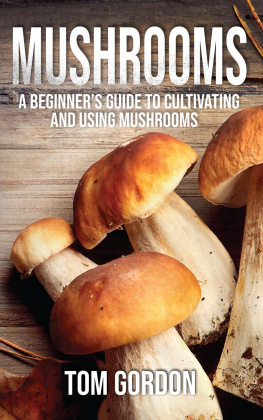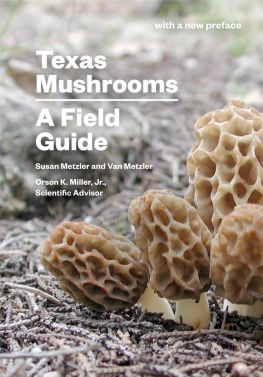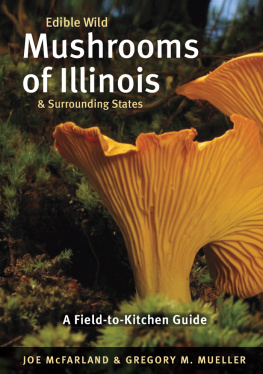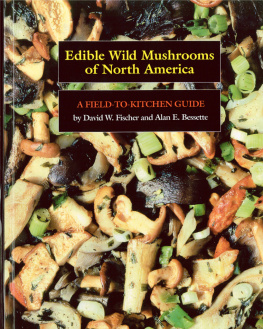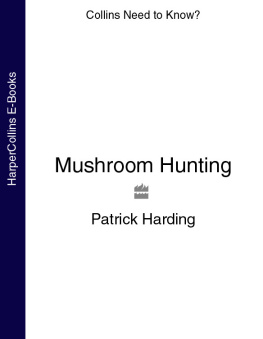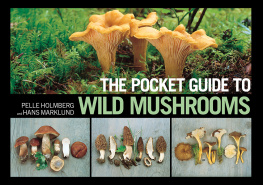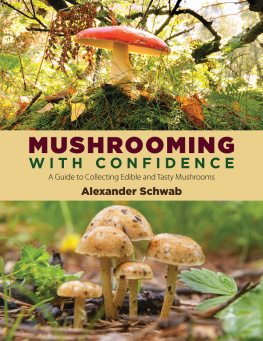
HALLUCINOGENIC AND POISONOUS
MUSHROOM FIELD GUIDE
Copyright 1977 by Gary P. Menser
Copyright 1997 by Gary P. Menser
ISBN: 978-1-57951-202-6
Published by
RONIN Publishing, Inc.
P.O. Box 3436
Oakland, Ca 94609
ALL RIGHTS RESERVED. No part of this book may be reproduced or transmitted in any form or by any means, electronic or mechanical, including photocopying, recording, on-line, or by any informational storage and retrieval system, without written permission from the publisher, except for the inclusion of brief quotes in a revew of this book.
NOTICE TO READER:
This Guide is not a substitute for professional training and experience. NEVER CONSUME ANY WILD MUSHROOM UNLESS ITS IDENTITY HAS BEEN CONFIRMED BY A SKILLED MYCOLOGIST. The Author and the Publisher of this Guide STRONGLY advise against anyone consuming wild mushrooms and take no responsibility for persons who recklessly do so. ALWAYS GET EXPERT ADVISE ON ALL WILD MUSHROOMS BEFORE CONSUMING THEM.
Distributed to the trade by Publishers Group West.
Color Photography:
Kit Scates: Galerina autumnalis, Amanita phalloides, Amanita pantherina, Gymnopilus spectabilis, Panaeolina foenisecii, Panaeolus campanulatus, Panaeolus fimicola, Panaeolus semiovatus, Panaeolus solidipes, Panaeolus subbalteatus, Psilocybe pelliculosa.
Bob Harris: Amanita muscaria, Panaeolus acuminatus, Panaeolus retirugis, Panaeolus subbalteatus, Psilocybe baeocystis, Psilocybe cubensis, Psilocybe stuntzii.
J.Q. Jacobs: Psilocybe baecystis, Psilocybe coprophila, Psilocybe cyanescens, Psilocybe cyanescens, Psilocybe cyanescens, Psilocybe pelliculosa, Psilocybe semilanceata, Psilocybe stuntzii.
Gary Menser: Psilocybe strictipes, Psilocybe baeocystis, Psilocybe semilanceata, Panaeolus castaneifolius.
Acknowledgements:
The author sincerely appreciates and acknowledges the technical assistance of Bill Sweet, Kit Scates, Paul Vergeer and Bill Burley; their advice has helped formulate my ideas and made this book possible. I wish to thank the illustrators whose collaboration was necessary. Finally special thanks goes to Terry and Scylla for their time and typing skills, and Tia, whose assistance and patience was, once again, indispensable.
Book Design by Hal Hershey
Cover Photo by Gary Menser
Line Drawings by Michael B. Smith
Typesetting by Richard Ellington
by William Griffith
In the mid 1970s when Gary Menser wrote Hallucinogenic and Poisonous Mushroom Field Guide, there were virtually no field guides available to the lay public for the psychedelic and poisonous mushrooms of the west coast. There were obscure journal articles, with no photographs and primarily scientific descriptions. In 1971 Leonard Enos wrote the first field guide, the Key to the North American Psilocybin Mushrooms, but this was largely a rehash of the scientific literature with some water colors. Having read this early literature, Gary Menser noted that many of the psychoactive species were in fact in his own back yard in Oregon, and he set out collecting them in the wild. He then hired an artist to construct the drawings and contacted various mycologist/photographers and assembled an excellent collection of photographs of the major poisonous and psychoactive species of mushrooms found on the West coast.
In simple and clear terms, Menser explained the mycological jargon so the average person would understand the characteristics needed to identify these mushrooms in the wild. The real beauty of this work is in its simplicity. The descriptions are easy to understand, and by following the information in the book, it is possible for the layperson to identify mushrooms in the wild. The book is clear, concise and was designed to be easily carried into the field (the original cover had a plastic coating so as to be impervious to water and had a metric ruler along the edge).
Hallucinogenic and Poisonus Mushroom Field Guide became the first of many mushroom field guides that appeared in the late 1970s and early 1980s. Some were very small uninformative publications while others were so full of scientific jargon that the average person could not understand them or fully utilize the information they contained. Since then most of these books have disappeared and gone out of print, making it difficult again for beginners to find the information needed to identify these mushrooms in the field. It is very timely that this book has been reprinted so that can be available again.
As Gary suggested in the original introduction, the purpose of this work is not to advocate the consumption of psychedelic mushrooms (and certainly not the consumption of poisonous ones either!) but is dedicated to informing people how to identify them. The question of the legality of consuming psychedelic mushrooms is really a larger one for society itself. Many of these mushrooms have been utilized for thousands of years in ritual or religious practices, and used for healing by various cultures. It is only in recent times that we find their usage and users being persecuted. The debate over the issue of ingesting consciousness-altering plants often leads to strong controversy in our society, which results in the creation of myths. It is the function of science in modern times to dispel these myths and replace them with facts. Gary wrote this book with the intention of taking a step in that direction.
At the outset we are confronted with the very nature of the terminology used to describe the psychoactive species. Poisonous mushrooms are those which contain any substance which when introduced into an organism [sic human] acts chemically to disrupt the normal biological processes resulting in hazardous effects or death. Psychoactive mushrooms are those which clearly act on the central nervous system functions and alter the higher consciousness. One could make the argument that these are indeed a form of poison as they disrupt the normal biological processes. However, it is generally agreed that for the most part these disruptions are not hazardous or life threatening. But is the term psychoactive sufficient to describe these mushrooms? Gary uses the term hallucinogenic mushrooms in the title, and then in the original introduction states The term hallucinogenic, when applied to the altered state of consciousness achieved through the ingestion of these mushrooms, is very misleading. He defines hallucinations as a psychological term for dissociative behavior such as seen in schizophrenics and psychotics. Rather he would have preferred the term pseudo-hallucinogenic. One should recall that these terms were first used in the early 1950s with the discovery of the psilocybin containing mushrooms. At that time the only paradigm available for describing these consciousness alterations came from abnormal psychology.
Subsequently, the scientific literature (at least as far as fungi were concerned) adopted the term psychotomemtic, but this would lead one to believe that the fungi induce a state of psychosis when this is not true. Psychedelic is often used to describe the state of ingesting psilocybin containing mushrooms and is used to imply mind manifesting. (The term is originates from the 1960s San Francisco and the artwork of the Haight-Ashbury scene.) In conclusion Gary settled on the term psychoactive which simply indicates an alteration of consciousness, without determining the effect of the alteration, a term which is relatively neutral. More recently, others have turned to the terms entheogens to describe the state of consciousness out of a desire to return to spiritual use which has historically characterized the use of the psychoactive mushrooms.
Next page

